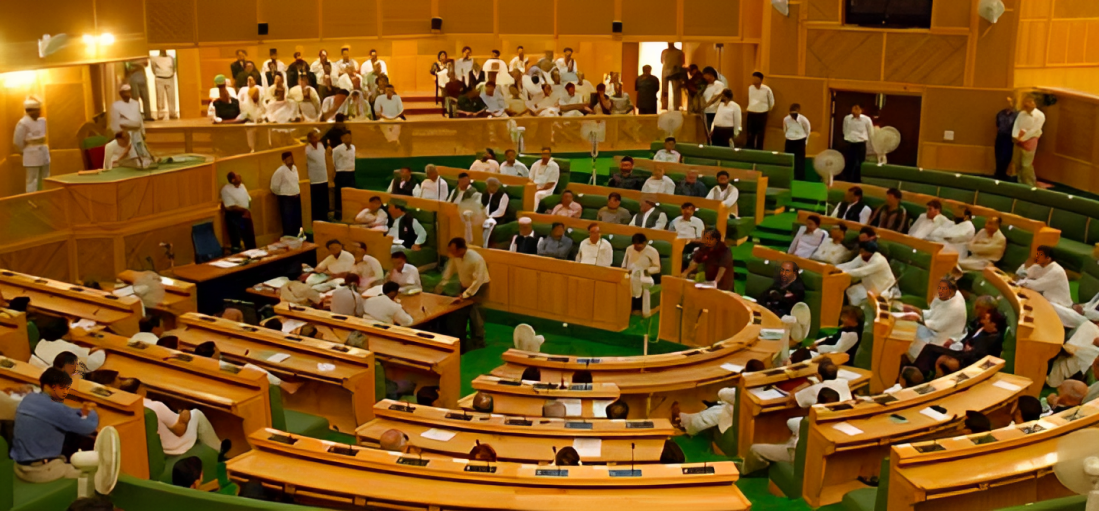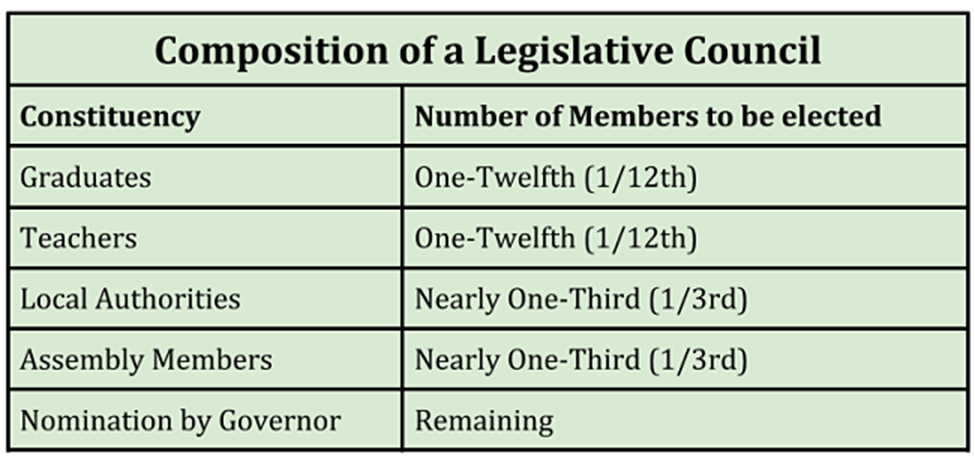Description

Copyright infringement not intended
Context: The Election Commission of India has decided to hold two separate bye-elections to the Uttar Pradesh Legislative Council.
Details
- The Uttar Pradesh Legislative Council is the upper house of the bicameral legislature of Uttar Pradesh, consisting of 100 members.
- 10 are nominated by the Governor and 90 are elected by various constituencies such as graduates, teachers, local authorities, and members of the legislative assembly.
About
- A State Legislative Council is the upper house of a bicameral legislature in some states of India.
- It is also known as Vidhan Parishad or Legislative Council.
- The composition and creation of the State Legislative Council are governed by Article 171 and Article 169 of the Constitution respectively.
- Only 6 out of 28 states have a Legislative Council. These are Andhra Pradesh, Karnataka, Telangana, Maharashtra, Bihar, and Uttar Pradesh. No union territory has a legislative council.
- The decision to establish or abolish a State Legislative Council depends on the state legislature and the Parliament of India.
.jpeg)
Eligibility and Tenure
- According to the Constitution of India, the eligible for the State Legislative Council, are:
- Be a citizen of India
- Be at least 30 years old
- Be registered as an elector for a parliamentary constituency in the state
- Not hold any office of profit under the government of India or the state government
- Not be disqualified by any law made by the parliament or the state legislature
- The tenure of the members is six years.
- One-third of the members of the Council retire after every two years.
Membership
- The State Legislative Council consists of members elected by various constituencies or nominated by the governor.
- The number of members in a state legislative council needs to be a minimum of 40 and it cannot exceed one-third of the total number of members in the state legislative assembly.
- MLCs are chosen in the following manner:
- 1/3rd are elected by the members of local bodies such as municipalities, Gram panchayats, Panchayat samiti and district councils.
- 1/3rd are elected by the members of the Legislative Assembly of the State from among the persons who are not members of the State Legislative Assembly.
- 1/6h are nominated by the Governor from persons having knowledge or practical experience in fields such as literature, science, arts, the cooperative movement and social services.
- 1/12th are elected by persons who are graduates of three years' standing residing in that state.
- 1/12th are elected by teachers who had spent at least three years teaching in educational institutions within the state not lower than secondary schools, including colleges and universities.

Function
- It acts as a check and balance on the state legislative assembly.
- It can review, amend, or reject bills passed by the lower house, except for money bills and bills related to the state budget.
- It can initiate bills that are not money bills and send them to the lower house for consideration.
- However, the lower house can override the decisions of the upper house by passing a bill again with a simple majority.
Significance
- It acts as a check on hasty legislation by scrutinising the bills passed by the State Legislative Assembly and suggesting amendments or modifications.
- This can ensure that the laws enacted are carefully analysed and thoroughly discussed.
- It prevents the autocratic tendencies of the lower house by holding it accountable and responsive to the public interest.
- It provides a platform for accommodating diverse talents and interests that may not be adequately represented in the lower house.
- It consists of members elected by different constituencies such as local bodies, teachers, and graduates, and nominated by the Governor for their distinguished services in various fields such as literature, science, art, cooperative movement, and social service.
- This can enable non-elected individuals who have expertise, experience, or eminence to contribute to the legislative process and enrich the quality of debate and deliberation.
- It helps in reducing the workload of the State Legislative Assembly by sharing some of its functions and responsibilities. A unicameral legislature may not be able to cope with the work and devote sufficient time and attention to the bills brought before it for enactment.
- The Council can lessen the burden of the lower house and enable it to focus on measures of greater importance.

Challenges
Limited Power
- The legislative power of the Councils is limited. Unlike Rajya Sabha which has substantial powers to shape non-financial legislation, Legislative Councils lack a constitutional mandate to do so.
- Assemblies can override suggestions/amendments made to legislation by the Council
Inadequate representation
- The Councils do not have enough representation from diverse sections of society.
- The electoral college for electing MLCs is often dominated by political parties and their affiliates.
- The nomination process by the Governor is also influenced by political considerations.
Lack of resources
- The Councils do not have adequate resources and infrastructure to function effectively. They often face a shortage of staff, space and research support. They also lack autonomy and accountability in their functioning.
No clear role and Process
- The Councils do not have a clear role and purpose in the federal system.
- They are often seen as a hindrance to speedy legislation and a platform for political patronage.
- They also create an asymmetry among states with regard to bicameralism.
Steps need to be taken
- To ensure that there is a consensus and consultation among all stakeholders before creating or abolishing a State Legislative Council. The views and interests of different political parties, civil society groups, and experts should be taken into account.
- To revise and update the criteria and methods for choosing the members of the State Legislative Council. The criteria should be based on merit, competence, and diversity. The methods should be transparent, fair, and democratic.
- To enhance the accountability and responsibility of the members of the State Legislative Council. They should adhere to a code of conduct and ethics. They should also be subject to regular scrutiny and evaluation by their electors and peers.
- To clarify and streamline the role and function of the State Legislative Council. They should complement and supplement the work of the State Legislative Assembly. They should also coordinate and communicate with each other effectively.
Conclusion
- The working of State Legislative Council plays an important role in ensuring that the laws passed by the lower house are in accordance with the Constitution and the public interest. However, it also needs to be more representative, accountable and transparent in its functioning. A comprehensive review of the eligibility criteria and the role of the Council is necessary to make it more relevant and responsive to the changing needs of society.
Must Read Articles:
Legislative Council: https://www.iasgyan.in/daily-current-affairs/legislative-council
Disqualification of Legislature: https://www.iasgyan.in/daily-current-affairs/disqualification-of-legislators
State Legislative Assembly: https://www.iasgyan.in/daily-current-affairs/state-assembly
|
PRACTICE QUESTION
Q. What are the advantages and disadvantages of having a bicameral legislature in a state, and how does the state legislative council ensure effective representation of diverse interests and accountability of the executive?
|

https://pib.gov.in/PressReleasePage.aspx?PRID=1921926












